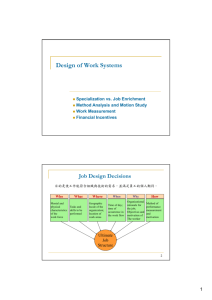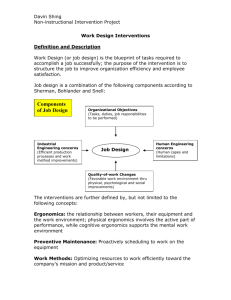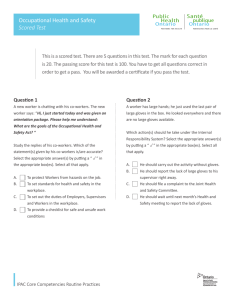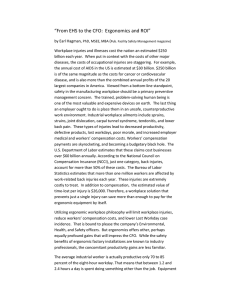All Aspects of the Industry – PowerPoint
advertisement
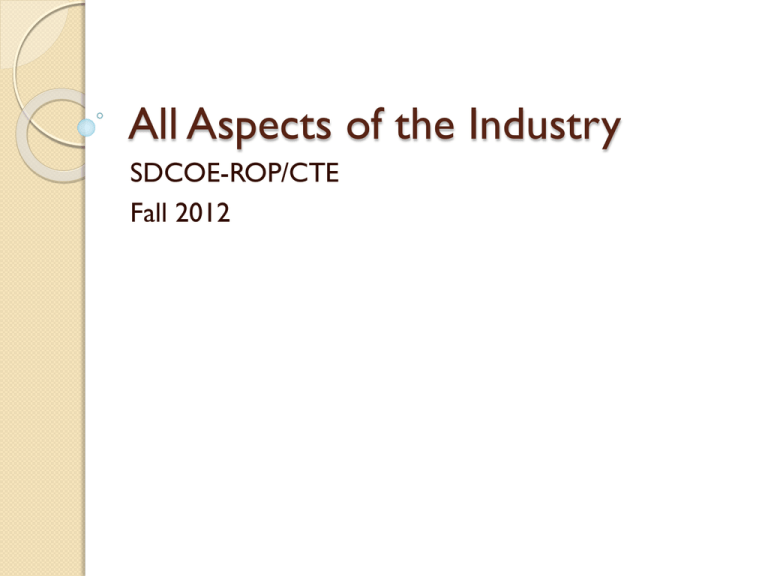
All Aspects of the Industry SDCOE-ROP/CTE Fall 2012 ALL ASPECTS “COMPONENTS OF AN INDUSTRY OR BUSINESS THAT MAKE THE BUSINESS SUCCESSFUL” Forges links between schools, businesses, and community institutions. Prepares students with a variety of skills in a fast-changing workplace. Students are shown the “Big Picture” of the industry and general technological principles important to the specific industry. Integrating academic and CTE Empowering learners to make career and life choices Enabling learners to adapt to technological change Involving learners in economic development Business Planning How regulatory laws can have an impact on a business’ operations. Ways an employee can influence company decision-making policy The differences between delivering products and delivering services. Business Planning Career Development Skills Distinguish between types of decisions ◦ Economic ◦ Technical ◦ Social Utilize problem solving skills ◦ ◦ ◦ ◦ Identity the problem for resolution Define critical issues Analyze causes of a problem Utilize research and assessment skills Examine results of a problem Offer solutions to a problem Select a solution to a problem Implement an action plan Prepare a business plan outline the costs to open a new business Design a floor plan for new equipment Interview a company on their hiring goals and objectives when hiring staff Management What is the “chain of command” ◦ How does the “chain of command” work What is the significance of a company’s workplace culture How cultural and gender diversity can have a positive effect on an industry Management Career Development Skills Outline the procedures involved in ordering, distributing, and controlling supplies Explain an ordering decision Requisition ◦ Supplies ◦ equipment Prepare a booklet outlining supply and equipment orders. Include examples of forms and what information is needed to process the requisition in a timely fashion. Health, Safety & Environment List Management’s responsibility for a safe workplace ◦ What are the benefits of good workplace ergonomics. How to avoid job-specific health threats The benefits of good workplace ergonomics Effects weather has on an industry Health, Safety and Environment Career Development Skills Comply with safety and health rules in a given work environment, including: ◦ Following established emergency procedures Exhibit the safe use of tools and equipment Maintain clean and orderly work area(s) Develop a set of instructions for medical emergencies Create a display to promote conservation for a community Earth Day Event Research what precautions are taken to make the buildings and surrounding parking lots safe at night Community Issues Why is a company’s public perception important? Why is it important for a company to provide access needs of the physically challenged? Why is it important for a company to contribute through volunteer work? Community Issues Career Development Skills In your industry, choose a company and list positive and negative perceptions Rate if your company is accessible to the physically challenged Develop a short range and a long range goal to change the public’s negative perception Create and present a PowerPoint on your company’s community projects Principals of Technology What are the basic resources necessary for your company What are ergonomics and why are they important What academic or technical education is needed to perform the technical and or production skills Principles of Technology Career Development Skills In your industry, develop a resource guide specific to your company Outline the level of education and or technical training needed for entry level positions Post the resource guide to the company’s website ◦ Develop and present the resource guide to employees Create and present a PowerPoint on the company’s entry level positions Personal Work Habits List non-technical skills and characteristics expected in the workplace What are the benefits of having a positive attitude, personal fitness and appearance and readiness to work Personal Work Habits Career Development Skills Why is it important to being fit for work? How would you characterize the company’s expectations regarding ◦ Attitude ◦ Appearance ◦ fitness Define and explain the importance of the following worker characteristics ◦ ◦ ◦ ◦ Cooperation Integrity Honesty Positive Attitude List and defend your strong worker characteristics List your worker characteristics that need further development Technical & Production Skills Research the certifications requirement for a specific position Obtain technical information and training for a specific position List positions that are inter-related Technical & Production Skills Career Development Skills What are the advantages of an industry certification? Research the technical training needed for a specific position List positions that are inter-related Locate information on positions requiring industry certification Develop a brochure on a specific position listing the technical training required Develop a spreadsheet that shows inter-related positions Labor Issues The importance of knowing your rights as a worker Advantages/disadvantages of hourly and salaried pay The importance of cultural sensitivity Labor Issues Career Development Skills Research your Develop and present your company’s employee rights as an employee rights Create a spreadsheet Develop a list of showing the salary and hourly advantages/disadvantages positions of salary and hourly pay Identify skills needed Create a brochure on to maintain effective cultural sensitivity for work relations with your company colleagues Finance What are the key factors effecting profit and loss What are the implications for a company extending credit How does the company acquire capital to operate? Finance Career Development Skills Research financial vocabulary List the steps of an accounting cycle How has technology increased and/or decreased the costs of operations Create a glossary of financial terms and there meaning Interview a financial manager on the accounting cycle ◦ Create a brochure Develop and present how technology increased and/or decrease the costs of operations



